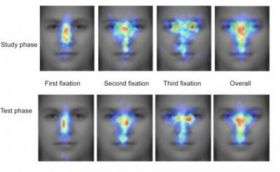When You Look at a Face, You Look Nose First

(PhysOrg.com) -- While general wisdom says that you look at the eyes first in order to recognize a face, UC San Diego computer scientists now report that you look at the nose first.
The nose may be the where the information about the face is balanced in all directions, or the optimal viewing position for face recognition, the researchers from UC San Diego's Jacobs School of Engineering propose in a paper recently published in the journal Psychological Science.
The researchers showed that people first look just to the left of the center of the nose and then to the center of the nose when trying to determine if a face is one they have seen recently. These two visual "fixations" near the center of the nose are all you need in order to determine if a face is one that you have seen just a few minutes before. Looking at a third spot on the face does not improve face recognition, the cognitive scientists found.
Understanding how the human brain recognizes faces may help cognitive scientists create more realistic models of the brain—models that could be used as tools to train or otherwise assist people with brain lesions or cognitive challenges, explained Janet Hsiao, the first author on the Psychological Science paper and a postdoctoral researcher in the computer science department at UC San Diego.
"The nice thing about models like neural nets is that—unlike computer programs—you can lesion them and they still run, which means you can test them in ways you could never test a human brain," said Garrison Cottrell an author on the paper and a computer science professor at UC San Diego's Jacobs School of Engineering.
"Understanding how the brain works is the greatest mystery facing us in this century and that is just what we are trying to do," said Cottrell, who directs the NSF-funded Temporal Dynamics of Learning Center (TDLC) at UC San Diego.
Eye Tracking Leads to Discovery
In the experiments reported in Psychological Science, subjects were shown images of faces they had seen a few minutes prior and images of faces they had never seen. The subjects had to decide in a very short time whether they recognized each face or not. Meanwhile, the researchers used eye tracking technology to monitor where on each face the subjects looked—and how long their eyes stayed at each location.
In particular, the researchers employed an innovative eye tracking approach that allowed them to control how many different places on the face subjects could "fix" their eyes before the image disappeared.
When subjects were allowed to fix their eyes on two different face locations, they performed better on face recognition tasks than when they were given the same amount of time but could only look at one spot on the face. Allowing a third for fourth fixation did not improve performance on face recognition tasks.
In the paper, the authors suggest that "...the second fixation has functional significance: to obtain more information from a different location."
Cottrell expanded on the idea. "The location of the second fixation, like the first, was almost always near the center of the nose. This means you are just shifting the face you are looking at on your retina a bit. This shift changes which neurons are firing in your retina and therefore changes the neurons in the cortex that the visual pattern goes to."
Psychological Science paper: "Two Fixations Suffice in Face Recognition," by Janet Hui-wen Hsiao and Garrison Cottrell, Department of Computer Science and Engineering, University of California, San Diego.
www.cse.ucsd.edu/~jhsiao/publi … ych-Science-2008.pdf
Provided by University of California - San Diego





















